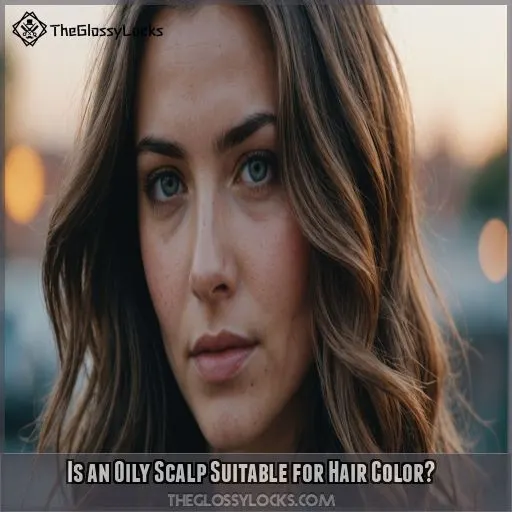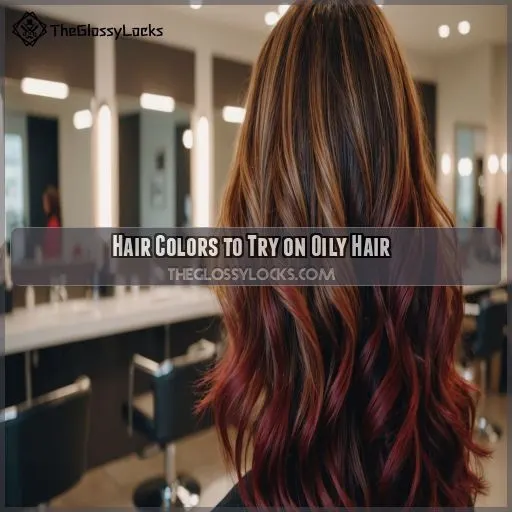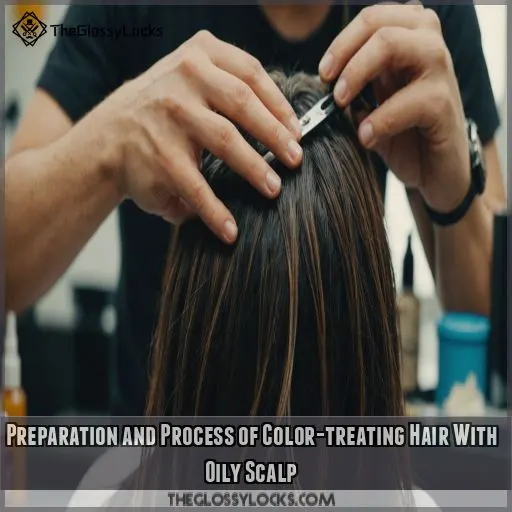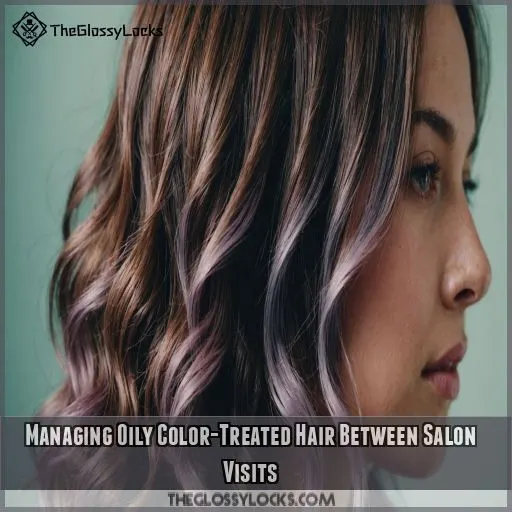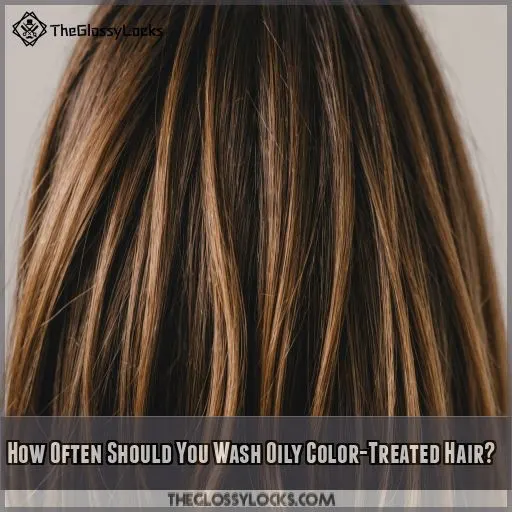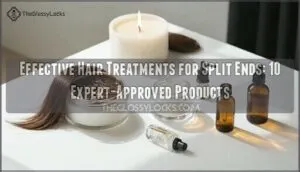This site is supported by our readers. We may earn a commission, at no cost to you, if you purchase through links.
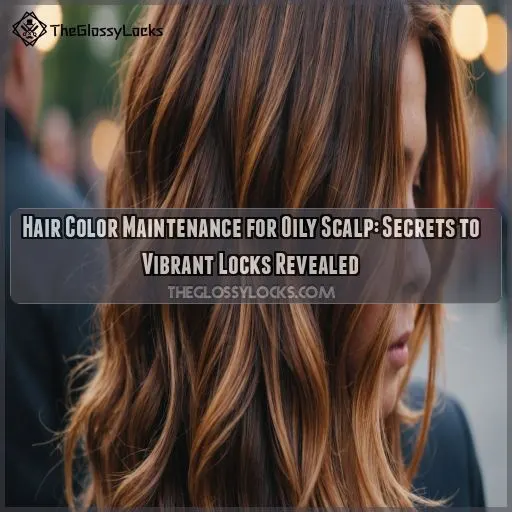 The eternal struggle of maintaining vibrant hair color with an oily scalp! Don’t worry, you’re not alone.
The eternal struggle of maintaining vibrant hair color with an oily scalp! Don’t worry, you’re not alone.
With a few key strategies, you can balance color preservation with scalp health.
First, First, you need to choose the right dye color.
. Lighter shades can make oiliness more noticeable, while darker shades can hide it but fade faster.
Using color-safe products and techniques, like balayage or ombre, can help create a multi-dimensional look.
But here’s the thing: hair color maintenance for an oily scalp requires more than just the right products – it’s about finding a balance that works for you.
Table Of Contents
- Key Takeaways
- Is an Oily Scalp Suitable for Hair Color?
- Hair Colors to Try on Oily Hair
- Preparation and Process of Color-treating Hair With Oily Scalp
- Options for Daily Shine Maintenance
- Managing Oily Color-Treated Hair Between Salon Visits
- How Often Should You Wash Oily Color-Treated Hair?
- Frequently Asked Questions (FAQs)
- Can I dye my hair if my scalp is oily?
- What hair color is best for greasy hair?
- How to keep colored hair from getting greasy?
- How to make dark hair not look greasy?
- How often should I use dry shampoo on oily scalp?
- What are the best hair masks for oily scalp issues?
- Can I use a sulfate-free shampoo on oily color-treated hair?
- How do I prevent oil buildup on my scalp at night?
- Can I use hair oils on oily scalp and dry ends?
- Conclusion
Key Takeaways
- You’re not alone in the eternal struggle of maintaining vibrant hair color with an oily scalp. The key is finding a balance that works for you, starting with choosing the right hair color – lighter shades can make oiliness more noticeable, while darker shades can hide it but fade faster.
- To keep your locks looking fresh and vibrant, use color-safe products and techniques like balayage or ombre to create a multi-dimensional look, and don’t be afraid to experiment with different hues to find what works best for your hair type and personal style.
- When it comes to color-treating your oily scalp, preparation is key – exfoliate your scalp before coloring to promote healthy growth, follow a pre-color treatment to open up your hair cuticles, and consider a color-protecting gloss to lock in your color and keep your scalp healthy.
- To maintain that vibrant shine on a daily basis, focus on preventing color fade by using the right products and techniques, such as mild shampoos, color-protecting shampoos, and deep conditioning treatments – and don’t forget to use dry shampoo to absorb excess oil without stripping your color-treated locks of moisture.
Is an Oily Scalp Suitable for Hair Color?
You’re considering coloring your hair, but you’re worried about your oily scalp – don’t worry, you’re not alone! With the right guidance, you can achieve vibrant locks that look great, even with an oily scalp, and it all starts with understanding the potential challenges and what hair color professionals want you to know (Source).
Potential Challenges for Colored Hair With an Oily Scalp
Coloring your locks with an oily scalp? That’s like trying to paint a masterpiece on a greasy canvas! You’ll face three main challenges:
- Color fade: Oily scalps can cause colors to dull faster.
- Scalp irritation: Scalp irritation: Chemicals in hair dye can exacerbate oiliness and irritation, especially if you don’t consider hair texture and health before dyeing .
.
- Product buildup: Using the wrong products can weigh your hair down, making it look greasier.
What Hair Color Professionals Want You to Know
Here’s the lowdown from hair color pros: Here’s the lowdown from hair color pros: an oily scalp can be a challenge for hair color due to underlying health issues, but it’s not a deal-breaker.
, but it’s not a deal-breaker. They want you to know that the right products and techniques can help maintain vibrant locks while keeping your scalp healthy. A good hair colorist will work with you to find a balance between color and salon shampoo benefits and scalp health.
.
Hair Colors to Try on Oily Hair
If you’re thinking about choosing a hair color for your oily locks, you’ve got a multitude of options – but not all hues are created equal.
Lighter shades can create the illusion of less oil, while darker shades can make your hair appear healthier and more vibrant.
Ultimately, it comes down to finding the perfect balance for your hair type and personal style.
Are Light or Dark Hues Best?
The age-old question: are light or dark hues best for oily scalps?
It’s not a one-size-fits-all answer.
Lighter shades can make oiliness more noticeable, while darker shades can hide it.
But, be aware that darker colors can fade faster.
Consider your skin tone, natural hair color, and personal style to make an informed decision that keeps your locks looking fresh and vibrant.
Creating Multi-dimensional Shades
Think you’re stuck with a one-dimensional color? Not so fast! With an oily scalp, multi-dimensional shades can create the illusion of thicker, healthier locks. Try balayage or ombre for a sun-kissed look, or opt for a color melt to blend your roots with the rest of your hair. Foiling and highlights can also add depth and dimension.
Preparation and Process of Color-treating Hair With Oily Scalp
When you’re getting ready to color your hair, you want to make sure it’s in the best condition possible.
This includes your oily scalp.
Recommended Tips From Expert Hairstylists
Now that you’ve picked the perfect hair color, it’s time to get ready for the color-treating process. To make sure your new color stays vibrant, expert hairstylists recommend the following tips:
- Use color-safe products to maintain your new hue.
- Exfoliate your scalp before coloring to promote healthy growth.
- Follow a pre-color treatment to open up your hair cuticles.
- Consider a color-protecting gloss to lock in your color.
Effects on Skin Health Due to Possible Cross-over Interaction
The not-so-glamorous side of hair coloring: skin irritation. When treating your oily scalp, it’s important to think about potential cross-over interactions. Think of it like a game of chemical tag – you don’t want any unwanted players crashing the party.
| Skin Irritation Risks | Prevention Tips |
|---|---|
| Color transfer | Wear gloves when applying color |
| Product residue | Shampoo thoroughly after treatment |
| Allergy risks | Do a patch test before coloring |
| Scalp sensitivity | Choose gentle, sulfate-free products |
| Breakouts | Keep hair away from face and neck |
Options for Daily Shine Maintenance
You’ve got your hair colored, and now you want to know the secrets to maintaining that vibrant shine on a daily basis – especially with an oily scalp. Let’s explore how to prevent color fade, the advantages of mild shampoos, Let’s explore how to prevent color fade, the advantages of mild shampoos, and whether you really need to use a color protectant shampoo to keep your locks looking their best.
.
How to Prevent Colour Fade
Now that you’ve color-treated your oily scalp, let’s talk about maintaining that vibrant color. To prevent color fade, you’ll want to use the right products and techniques. Here are some tips to keep your locks looking fresh:
- Use color-safe products to avoid stripping your hair of its color.
- Protect your hair from the sun with a hat or hair serum.
- Treat your hair to deep conditioning sessions to keep it moisturized.
- Rinse your hair with cool water to close the cuticle and lock in color.
What Are the Advantages of Mild Shampoos
Now that you’ve learned how to prevent color fade, let’s talk about the secret to gentle cleansing – mild shampoos!
These game-changers promote scalp health, maintain color vibrancy, and leave your locks feeling soft.
Plus, they reduce irritation, a total win for oily scalps.
Do You Need to Use a Colour-protecting Shampoo
Let’s get real – color-treated hair needs extra TLC. To keep your locks vibrant, consider a color-protecting shampoo. It’s like a force field for your hair, shielding it from color-fading culprits like water and sunlight. Look for a color-safe shampoo that’s sulfate-free and formulated for oily hair to keep your scalp and strands healthy.
Managing Oily Color-Treated Hair Between Salon Visits
Managing oily color-treated hair between salon visits can be a challenge, but with the right techniques, you can keep your locks looking vibrant and healthy. By incorporating dry shampoo, adjusting your washing frequency, and treating your hair to deep conditioning treatments, you’ll be able to maintain that fresh-from-the-salon look without breaking a sweat.
Use of Dry Shampoo
Time to tame the oil beast between salon visits. You can use dry shampoo to absorb excess oil without stripping your color-treated locks of moisture. Here are some dry shampoo tips:
- Use it 1-2 days out of 3-4 days without washing
- Choose a dry shampoo that won’t leave residue or dull your color
- Spray it only on oily areas
- Massage it in to distribute evenly
- Style as usual for a refreshed look
Frequency of Washing
You’ve mastered the art of dry shampooing, but now it’s time to get down to business: washing your oily, color-treated locks. Finding the perfect washing frequency is key. Over-washing can lead to color fade, while under-washing can make your scalp oilier. Aim for 3-4 washes a week, depending on your hair type, and adjust as needed.
Deep Conditioning Treatments
The sweet salvation of deep conditioning treatments! To keep your oily, color-treated locks looking their best between salon visits, indulge in a hair mask once or twice a week. Here are three tips to get you started:
- Choose the right product: Look for hydrating masks that won’t weigh your hair down.
- Focus on the ends: Apply the mask from mid-lengths to ends to target dryness.
- Leave it on: Let the mask work its magic for 15-30 minutes before rinsing.
How Often Should You Wash Oily Color-Treated Hair?
When you have oily, color-treated hair, it can be tough to know how often to wash it.
Too much washing strips away the color and moisture.
Too little washing leaves you with a greasy mess.
Finding the sweet spot will help you keep your locks looking vibrant and healthy.
Let’s figure out the ideal washing schedule for your oily, color-treated tresses.
Over-washing Vs Under-washing
The age-old debate: over-washing vs under-washing. Oily color-treated hair, finding the right balance is important. Over-washing strips your hair of its natural oils, leading to dryness and damage, while under-washing can leave your locks looking greasy. Aim for 3-4 washes a week to maintain scalp balance and promote healthy hair growth.
Balance the Cleansing of Oily Hair Scalp Skin Care
The delicate dance of washing oily, color-treated hair! You want to find the sweet spot between over-washing, which strips your locks of color and moisture, and under-washing, which leaves your scalp feeling greasy. Aim for 2-3 washes a week, using a gentle, sulfate-free shampoo and conditioner duo that nourishes your dry ends without exacerbating your oily scalp.
Frequently Asked Questions (FAQs)
Can I dye my hair if my scalp is oily?
You can dye your hair with an oily scalp, but it’s best to shampoo your hair 2-3 days beforehand to allow for some oil to remain, which can help protect your scalp and hair .
What hair color is best for greasy hair?
When you’ve got greasy hair, it’s best to opt for a hair color that creates the illusion of cleaner locks. Go for a balayage or subtle highlights that add dimension without accentuating oiliness – your hair will thank you!
How to keep colored hair from getting greasy?
Imagine Sarah, a busy bee with vibrant red locks. To keep her colored hair from getting greasy, she uses a sulfate-free shampoo and conditioner, and applies a dry shampoo on non-wash days to absorb excess oil.
How to make dark hair not look greasy?
Want to keep your dark locks looking fresh? Try using a clarifying shampoo once a week to remove product buildup, and apply a lightweight, oil-absorbing dry shampoo to soak up excess grease on non-wash days.
How often should I use dry shampoo on oily scalp?
Did you know 40% of people use dry shampoo daily? However, for an oily scalp, use it sparingly – 1-2 days out of 3-4 days without washing – to absorb excess oil without stripping hair of moisture.
What are the best hair masks for oily scalp issues?
You can tame oily scalp issues with the right hair masks! Try the artnaturals Argan Oil & Aloe Hair Mask , Verb Ghost Hair Mask , Try the artnaturals Argan Oil & Aloe Hair Mask, Verb Ghost Hair Mask, or the Amika Soulfood Nourishing Hair Mask for deep conditioning treatments and nourishment.
.
Can I use a sulfate-free shampoo on oily color-treated hair?
You can use sulfate-free shampoo on oily color-treated hair, but choose one that gently removes excess oil without stripping color, and pair it with a moisturizing conditioner to hydrate dry ends .
How do I prevent oil buildup on my scalp at night?
An ounce of prevention is worth a pound of cure." To prevent oil buildup at night, wash your hair in the evening if needed, and use a dry shampoo or a scalp serum to absorb excess oil while you sleep.
Can I use hair oils on oily scalp and dry ends?
You can use hair oils on an oily scalp and dry ends, but choose the right oil and application method to avoid exacerbating oiliness . Use a small amount, focusing on ends, and avoid the scalp (Source).
Conclusion
If you’re dealing with an oily scalp and want to maintain your hair color, you’re not "dying" to find a solution – but it can feel that way!
It can feel like a challenge to keep your hair color vibrant while dealing with an oily scalp.
By choosing the right hair color, using color-safe products, and finding a balance that works for you, vibrant locks are within reach.
With these secrets revealed, you’ll be rocking a fresher, healthier ‘do in no time.

